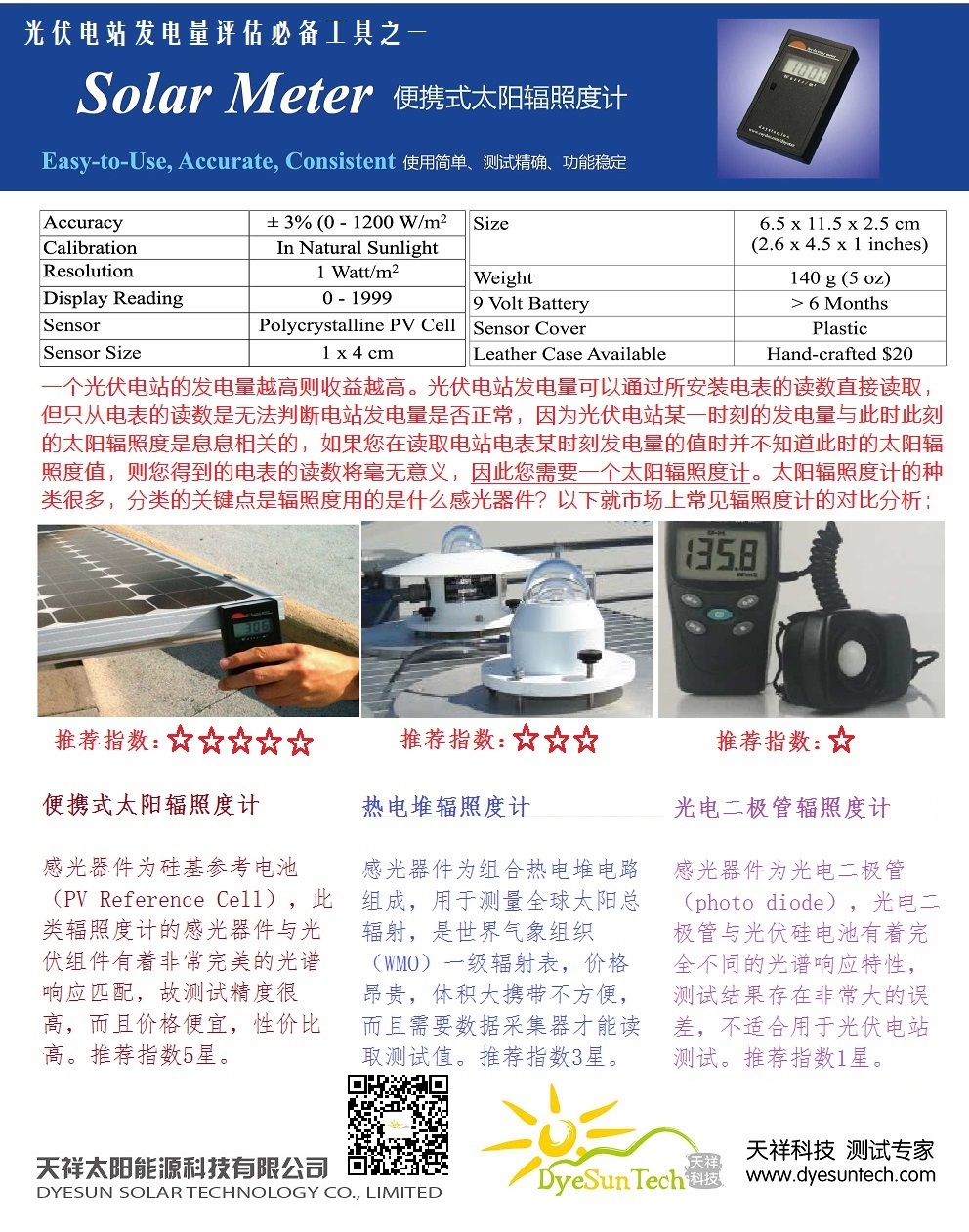便携式太阳辐照度测试仪

详细技术介绍如下:
光强感应器件:
PV Sensor: The meter uses a polycrystalline silicon PV cell as the sensor. The cell is
mounted on the top end of the meter, perpendicular to the display. The sensor responds to a
spectum bandwidth of approximately 0.3-1.1 microns. A generic spectrum for a silicon PV
cell show as below. The meter is intended for outdoor measurements of natural sunlight. The
PV sensor is located behind a plastic diffuser.
经过一级计量校准:
Meter Calibration: Meters are calibrated on clear days in natural sunlight and adjusted to a
reference cell periodically calibrated with pyranometers at Sandia National Laboratories.
Meters are pointed directly at the sun for calibration with the plastic protection cover in place.
Off-angle calibration is not done. However, empirical data indicate meter-to-meter
performance remains consistent up to 40 degrees off-angle from the direct normal. Beyond
40 degrees the readings start to diverge and may reach 10 - 15% when pointed 70-80 degrees
away from the sun. The meters are calibrated in groups and records for individual meters are
not maintained.
使用注意事项:
Care of your Meter: The meters are designed for use in the field but you should treat them
as you would your voltmeter; avoid dropping them, do not leave them out in the rain. They
are not sealed for continuous exposure to weather. The LCD display may darken if exposed
to direct sunlight for a prolonged period.
售后维护:
Meter Repair: We stand behind our products. If your meter is damaged or malfunctions,
contact Daystar for instructions about repair or return. A repair charge may may assessed if
your meter is more than one year old.
如何计算整个电站的辐照量:
Using Your Meter:The Daystar solar meter measures instantaneous solar power and provides the reading
in Watts per square meter. You can calculate the total power striking the PV array by multiplying the area
of the active PV material by the reading from the meter. You can estimate the output power from the PV
array for that condition by multiplying by the advertised module efficiency. You would have to adjust that
value for losses, temperature effects, inverter efficiency, etc., to obtain the actual system output. More
information is available as a .pdf download here.

光谱响应曲线
Light Spectrum
The Daystar meter PV cell sensor responds to light from approximately 500 to 1100 nanometers, show as
above.
测试仪操作指南,步骤如下:
Do the following:
• Hold or place the Daystar solar meter in the same orientation as the PV array.
Record the reading of irradiance (solar power) in Watts per square meter.
Note: If possible, a PV array should be tested on a clear day around solarnoon.
• Consult the PV module specification to determine the area of the PV array.
This should be the “active area” of the PV cells excluding the frame of the
PV modules. Calculate the active area in square meters.
• Multiply the irradiance reading and the active area to get total solar power
striking the the array at that instant, the input power (Watts).
• Consult the PV module specifications to determine the conversion efficiency
of the PV modules used in the array.
• Multiply the input power by the efficiency to estimate the power the array
could produce under existing conditions.
• In most instances, this number will be greater than the output power
because losses and temperature effects have not been considered.
相关文章及产品:









